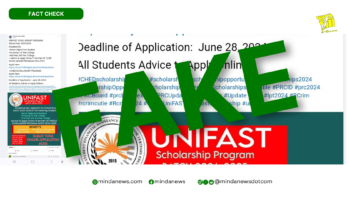It’s a sunny morning in the fishing village of Burgos, and the narrow banca is gliding past a maze of fish corrals towards a guardhouse in the middle of lush beds of seagrass. Colored flags flutter in the cool breeze, marking the boundary of the marine sanctuary. In the depths of the clear waters are healthy coral reefs, and thick mangrove forests line the shore.
For the third year in a row, Barangay Burgos has won the best marine sanctuary award in the town of Cortes, and it is easy to see why. The 67-hectare protected area is a no-take zone, which means fishing is only allowed outside the boundary, and the community organization Kaampaka(Kadagatan Ampingan Pagmata Katawhan) is vigilant in conserving the resources.
“Dagko man gud ang isda sa sulod sa sanctuary, mao nang mokawat gyud sila,” (The fish inside the sanctuary are really big, that’s why illegal fishers come and steal them) says Mary Jean Pame, who is in charge of fish processing and marketing projects.
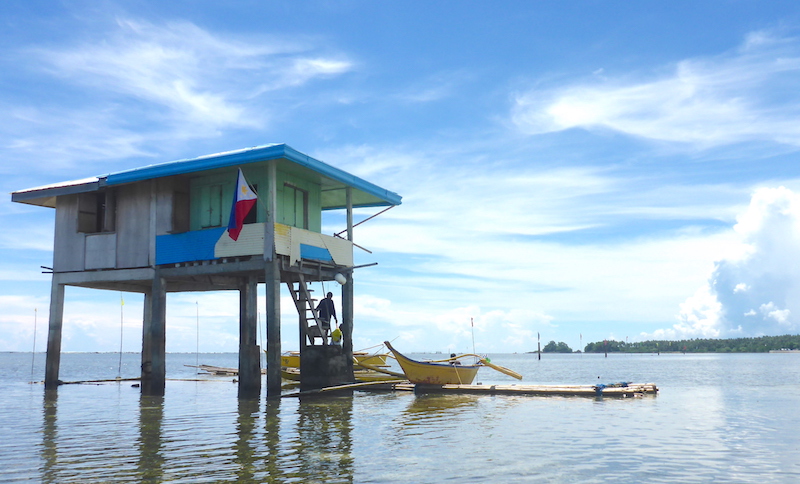 Marine Protection Area guardhouse in Burgos, Cortes town in Surigao del Sur.
Marine Protection Area guardhouse in Burgos, Cortes town in Surigao del Sur.
Commercially valuable species inside the sanctuary include danggit and lapu-lapu. On a good day, licensed fishers can catch up to 30 kilos outside the sanctuary, she says.
The group’s members take turns at the guardhouse, on the lookout for fishers who encroach inside the sanctuary. They take photos of violations and record everything in a logbook, which is submitted to the municipal government’s Civil Society Development Office. Dialogue with erring fishers is the preferred mode of resolving conflicts, and the guards don’t carry guns.
“Dili man maayo nga awayon nato sila o kasuk-an kay magdumot ma na. Kung daghan sila moatake unya gamay lang mi, mapildi mi,” (It’s not good to quarrel with or reprimand them because they will harbor ill will. If many of them attack us, we’re going to lose because we’re only a small group) says Inocencio Cabuga, the 70-year old manager of Kaampaka.
The fishers’ group started with five members in 1998 and reached a peak of more than 60, but their numbers dwindled after they were threatened by illegal fishers, who burned down their watch tower in 2001. Kaampaka founder and chairman Benjamin Dellosa wrote about the incident in a poem displayed prominently inside the guardhouse, a constant reminder of the challenges they have overcome. Around 30 members are currently active, sharing a minimal allowance from the municipal government for guarding the sanctuary round the clock. They plan to spend their P5,000 prize money from their latest award for fishing enterprises.
From corporate life to small-town mayor
The success of Burgos reflects the dynamism of Cortes, a small town in Surigao del Sur that surprised hundreds of coastal municipalities when it became the first winner of the Malinis at Masaganang Karagatan award from the Bureau of Fisheries and Aquatic Resources (BFAR).
Sharing a meal of freshly caught crabs and squid with journalists, Pame says local residents credit the transformation of Cortes from a sleepy coastal town to national winner on their youthful leader, Mayor William Angos. He has vigorously championed marine conservation since taking office in 2013, and doesn’t like to see garbage on the shoreline or the coastal waters, so fishers like Pame and Cabuga strive to keep their surroundings clean.
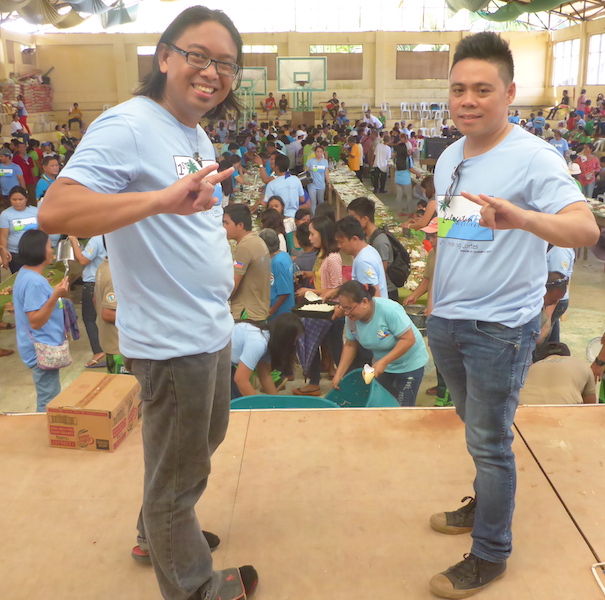 Mayor William Angos (L) of Cortes town in Surigao del Sur has vigorously championed marine conservation since taking office in 2013 with Vincent Dueñas, who wears multiple hats as head of the coastal resource management, tourism, and civil society offices in the local government.
Mayor William Angos (L) of Cortes town in Surigao del Sur has vigorously championed marine conservation since taking office in 2013 with Vincent Dueñas, who wears multiple hats as head of the coastal resource management, tourism, and civil society offices in the local government.
Angos left his previous life as a corporate lawyer, certified public accountant, and college teacher in Davao City to embark on an adventure in local governance in his hometown. Trading his suit and tie for T-shirts and open sandals, he cuts a maverick figure with his long hair and reserved demeanor. Inside the mayor’s office, he shares a long worktable – where he also receives visitors – with senior staff clicking away on their laptops.
The journey to national recognition for Cortes did not come easy, says Angos, as he narrates a litany of basic needs that had to be addressed before the town’s fishers and farmers latched on to the sustainable fisheries bandwagon. From providing school buses and dental kits for children, to vocational training for jobless youth, the 42-year-old mayor went through a trial-and-error process until he managed to get Cortes on a path that would balance environmental protection with economic productivity.
“I thought it was going to be a vacation,” he recalls with a laugh, saying he was attracted by the ecotourism potential of Cortes. The fourth-class municipality has become a popular destination in recent years because of Laswitan waterfalls, a natural rock pool on the coast that attracts hordes of selfie-seeking visitors during the peak season from November to January. Angos was concerned that unregulated tourism development, including a toilet and concrete structures built right on the craggy shoreline that are buffeted by Surigao’s famous surfing waves, would destroy its natural beauty.
Right after his election, Mayor Angos started working on his vision, spending five million pesos in rehabilitating Laswitan Falls. With very few jobs in town, training centers for skills like carpentry and masonry were set up for some 2,000 out-of-school youth. Law enforcers went after illegal fishers, with almost 700 giving up banned gear like beach seine and dragnet.
“The good thing was that I started on the first day,” the mayor says. “After two years, we were able to produce results.”
Fish abundance increased in nearshore waters, and coastal residents soon found fishing a lucrative source of income to supplement coconut farming. Out of 600 registered fishers in 2013, the number soared to more than 3,000 and the mayor realized that this was what the youth of his town really wanted to do, instead of getting technical education.
“Culturally, mao lang gyud ilang naandan, panagat lang gyud,” (They have really been into fishing for a long time) Angos says. Drawing on this insight, he is trying to utilize the town’s boat-building tradition and local skills so fishers could make vessels that can go out to deeper waters. This would reduce fishing pressure near the shore, and allow the population of the most vulnerable fish species to recover and grow to adult sizes.
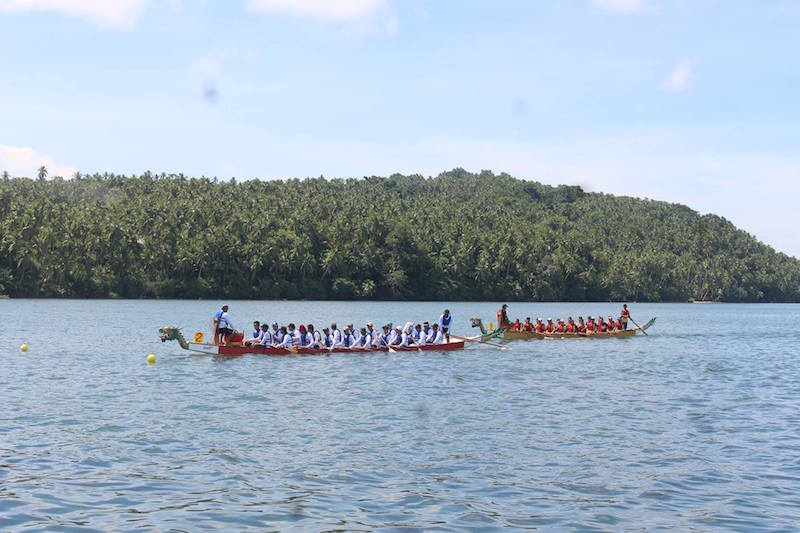 Dragon boat race teams of Cortes town, Surigao del Sur.
Dragon boat race teams of Cortes town, Surigao del Sur.
Mayor Angos also found interest among high school students in dragon boat racing, a natural fit for kids who grew up paddling boats with their parents in the vast coastal waters. With a fiberglass boat costing P200,000, the municipal rowing team has to be content with a wooden boat for practice runs. Angos is raising funds to develop a strong team, seeing this strategy as a “fighting chance for locals to get varsity scholarships” if they want to go to college.
From conservation to economic security
Cortes has benefited from marine conservation projects for many years now, resulting in high environmental awareness among residents. However, illegal fishing persists, and Mayor Angos believes this is due to lack of financial resources and basic services.
“Unless you address their hunger pangs, they will keep abusing our environment. When they have to attend meetings, they worry about their children going home from school in a habal-habal,” he says, referring to the overloaded motorbikes that serve as the main form of transport in rural areas.
The municipal government’s campaign to provide basic needs and look at “conservation as a social problem” won the nod of the judges in BFAR’s search for outstanding coastal community, giving a windfall of P20 million to Cortes for its livelihood projects.
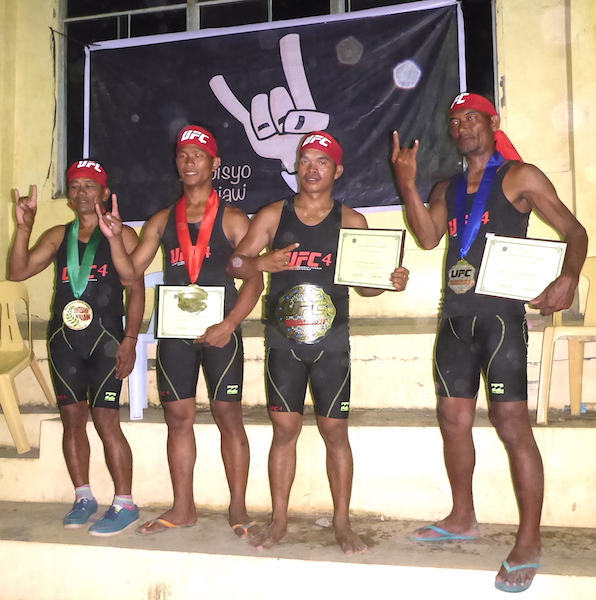 UFC for Ultimate Fishers’ Champion. an innovative contest that tests practical skills and environmental awareness. The competition is the brainchild of Vincent Dueñas, who wears multiple hats as the head of the coastal resource management, tourism, and civil society offices in the local government.
UFC for Ultimate Fishers’ Champion. an innovative contest that tests practical skills and environmental awareness. The competition is the brainchild of Vincent Dueñas, who wears multiple hats as the head of the coastal resource management, tourism, and civil society offices in the local government.
During the celebration of the Araw ng Cortes last October 1, the municipal government used some of the funds to provide organic fertilizer for coconut farmers as well as rice subsidies. Cash prizes also went to the winners of the Ultimate Fishers’ Champion, an innovative contest that tests practical skills and environmental awareness. The competition is the brainchild of Vincent Dueñas, who wears multiple hats as the head of the coastal resource management, tourism, and civil society offices in the local government.
As one of the first conservation fellows of Rare, an international NGO that promotes sustainable fisheries in the Philippines, Dueñas designed a local campaign that encouraged appreciation of marine resources through creative means such as festivals and contests. He realized, however, that his town mates were looking for tangible rewards.
“Social marketing is only effective if it has benefits,” he says. “The problem with some environmentalists is that they only look at natural resources and not people.”
Dueñas has been working in tandem with Mayor Angos to find solutions to the challenges of addressing the basic needs of Cortes residents, while persuading them to protect the sources of their livelihood.
“We have very little resources. When I started, collection was only P1 million and it’s now around P5 million, in addition to our internal revenue allotment of P60 million. We can stretch our budget as long as we use it properly. It really depends on how you prioritize your expenses,” says Angos.
Pointing to several boxes stacked on the floor of his office, the mayor says they contain donations of dental kits that will be distributed to children. “I believe na kung walay bata nga musakit ang ngipon, dako na kaayo na ug impact sa economic condition sa isa ka pamilya,” (If we don’t have kids with toothaches, that already has a huge impact on one family’s economic condition), he says.
For this year’s BFAR contest, Cortes was proclaimed the finalist in the Caraga region, with their entry, “Human development is the key to sustainable conservation.” The mayor sees this progression as the logical step in moving towards self-reliance. “If dole-out mentality prevails, they will still go back to their old ways,” he notes.
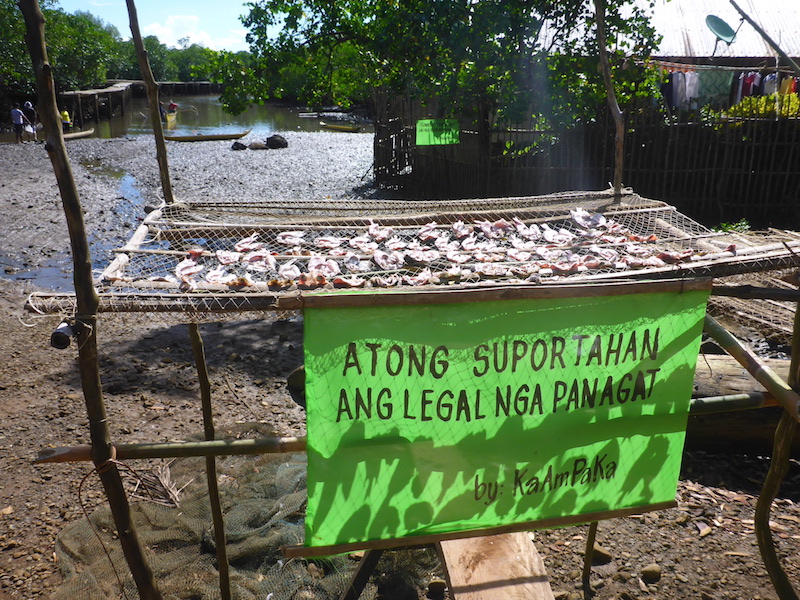 Drying fish in Burgos, Cortes town.
Drying fish in Burgos, Cortes town.
“Next year, we are looking at economic security as our theme for the contest,” Angos adds. Cortes was once merely a barangay of what is now the capital city of Tandag, and the mayor is striving to turn the municipality into a thriving trading post. After all, it is a major producer of premium seafood such as crabs, prawns, and lobsters. A fish landing center and ice plant are opening soon in barangay Tigao, and the challenge for Cortes in the future is how to ensure that marine catch would not exceed the capacity of their seas to replenish the resources.
The author is the senior communications manager in the Philippine office of Rare, an international conservation organization that promotes sustainable management of municipal waters and responsible fishing behavior among Filipino fishers. For more information, visit www.rare.org/philippines
